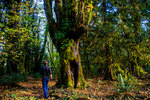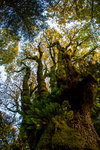

EAST LEWIS COUNTY — As the sun inches toward the horizon of a nearby hillside, I slip through a gate behind an orchard and into a thicket of thorns and vines. My guide is a few steps ahead, clearing the way with short swings of his folding saw. His dog, less bothered by the tangle, barks unseen well into the trees.
“This is probably the easiest way,” he tells me, “and it’s not very easy.”
James is taking me to see a grove of centuries-old bigleaf maples that he discovered on the back end of his property. Last week, I’d written about some old-growth cedars and firs hidden in the Gifford Pinchot National Forest, and James emailed to ask if I wanted to expand my beat to deciduous trees.
“I will be happy to take you beyond the fence line and to this secret place,” he wrote. “It’s truly a sight to see this time of the year with the fall colors.”
I drove out the next day.
Bigleaf maples are one of the Northwest’s most abundant hardwoods, but the tree has suffered from a mysterious die-back in recent years, and scientists have yet to figure out the problem. James said the trees have been especially hard-hit in Lewis County, with stands of maples producing scorched leaves or bare branches as they succumb.
The trees are also under threat from poachers, because the wood grain in certain bigleaf maples is prized by guitar manufacturers, making them a high-value target. In 2015, authorities busted a poaching ring that had decimated a stand of bigleaf maples in the national forest, selling the lumber to a sawmill in Winlock. James estimated just one of the trees on his property could be worth more than $10,000.
For that reason, The Chronicle is not identifying the location of the trees, and is only using James’ first name.
We make our way through a stand of alders, fight off blackberry vines and then we’re there, in an opening among knobby, moss-draped sentinels, walking on their carpet of foot-wide leaves. The waning sun turns the golden leaves ablaze.
Unlike their ramrod-straight conifer cousins, bigleaf maples take a circuitous route to the sky, gnarly trunks often dividing near the base and branches splaying in one direction or another. On a single tree, the branches careening around at crazy angles looks disorderly. In a grove of them, though, they reach out to form archways and sky-corridors, the leaves filling in the gaps like stained glass. I say the ambience is almost reverential, and James says the trees had the same effect on him when he discovered them about a year ago.
“It’s the same feeling that I got when I was in churches in Europe,” he says. “It’s very tall, almost pillars, columns — the way the tree branches come together, it’s almost like arches. It’s so humbling, it’s like standing in a 400-year-old church. You have that same sense of age. What’s unique about about there is that it just happened. It’s not like anybody drew up plans for it. There’s no architectural plans for how the woods should feel, but you go back there and there’s this sort of sense of intent.”
What makes these trees unique is that they’re not in the protected sanctuary of a national park or forest. They’re on private land, still undeveloped, touched only by time. On the walk back to the trees, James says he’s thinking about putting in a boardwalk to make them more accessible, maybe putting the word out so others can experience the grove. When we return from the solitude, back to the developed portion of his land, he’s not so sure.
“I’m glad that no one before has ever done anything here,” he says. “Maybe I should just continue that legacy. Don’t invite tons of people back there and just try to keep it as wild as it can be. I go back and forth on that.”
Regardless, he’s determined the trees won’t feel the bite of a saw, no matter their value.
“It’s definitely not going anywhere,” he says.
For now, he’s going to keep making pilgrimages to the grove, notwithstanding a scrape or two on his arms, knowing their future may be tenuous.
“It makes me really hope that we can figure out a way to treat the die-back that’s happening with bigleaf maple, because they’re such a cool tree,” he says. “Lewis County and the Cowlitz River valley has been hit really hard by it. We’ve got it worse than just about anywhere.”
While James’ trees will remain in seclusion, a walk on Centralia’s Seminary Hill offers an easy way to see plenty of still-healthy bigleaf maples, showing off their golden autumn radiance. The occasional passing train might break the stillness, but the trees stretch out their canopy unbothered, striating the sky and slowly collecting a golden carpet below.